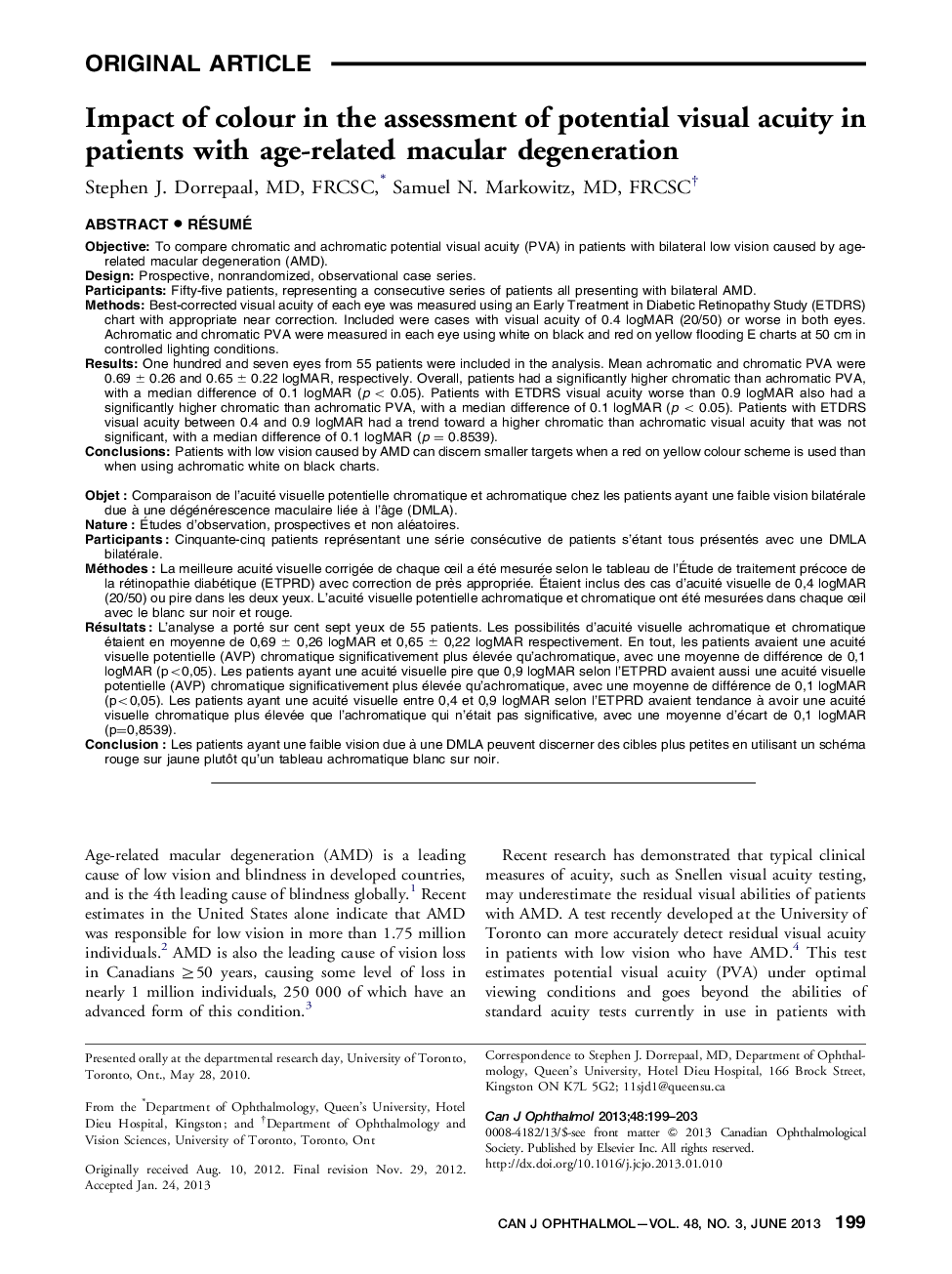| کد مقاله | کد نشریه | سال انتشار | مقاله انگلیسی | نسخه تمام متن |
|---|---|---|---|---|
| 4009756 | 1602409 | 2013 | 5 صفحه PDF | دانلود رایگان |

ObjectiveTo compare chromatic and achromatic potential visual acuity (PVA) in patients with bilateral low vision caused by age-related macular degeneration (AMD).DesignProspective, nonrandomized, observational case series.ParticipantsFifty-five patients, representing a consecutive series of patients all presenting with bilateral AMD.MethodsBest-corrected visual acuity of each eye was measured using an Early Treatment in Diabetic Retinopathy Study (ETDRS) chart with appropriate near correction. Included were cases with visual acuity of 0.4 logMAR (20/50) or worse in both eyes. Achromatic and chromatic PVA were measured in each eye using white on black and red on yellow flooding E charts at 50 cm in controlled lighting conditions.ResultsOne hundred and seven eyes from 55 patients were included in the analysis. Mean achromatic and chromatic PVA were 0.69±0.26 and 0.65±0.22 logMAR, respectively. Overall, patients had a significantly higher chromatic than achromatic PVA, with a median difference of 0.1 logMAR (p<0.05). Patients with ETDRS visual acuity worse than 0.9 logMAR also had a significantly higher chromatic than achromatic PVA, with a median difference of 0.1 logMAR (p<0.05). Patients with ETDRS visual acuity between 0.4 and 0.9 logMAR had a trend toward a higher chromatic than achromatic visual acuity that was not significant, with a median difference of 0.1 logMAR (p = 0.8539).ConclusionsPatients with low vision caused by AMD can discern smaller targets when a red on yellow colour scheme is used than when using achromatic white on black charts.
RésuméObjetComparaison de l'acuité visuelle potentielle chromatique et achromatique chez les patients ayant une faible vision bilatérale due à une dégénérescence maculaire liée à l'âge (DMLA).NatureÉtudes d'observation, prospectives et non aléatoires.ParticipantsCinquante-cinq patients représentant une série consécutive de patients s'étant tous présentés avec une DMLA bilatérale.MéthodesLa meilleure acuité visuelle corrigée de chaque œil a été mesurée selon le tableau de l'Étude de traitement précoce de la rétinopathie diabétique (ETPRD) avec correction de près appropriée. Étaient inclus des cas d'acuité visuelle de 0,4 logMAR (20/50) ou pire dans les deux yeux. L'acuité visuelle potentielle achromatique et chromatique ont été mesurées dans chaque œil avec le blanc sur noir et rouge.RésultatsL'analyse a porté sur cent sept yeux de 55 patients. Les possibilités d'acuité visuelle achromatique et chromatique étaient en moyenne de 0,69 ± 0,26 logMAR et 0,65 ± 0,22 logMAR respectivement. En tout, les patients avaient une acuité visuelle potentielle (AVP) chromatique significativement plus élevée qu'achromatique, avec une moyenne de différence de 0,1 logMAR (p<0,05). Les patients ayant une acuité visuelle pire que 0,9 logMAR selon l'ETPRD avaient aussi une acuité visuelle potentielle (AVP) chromatique significativement plus élevée qu'achromatique, avec une moyenne de différence de 0,1 logMAR (p<0,05). Les patients ayant une acuité visuelle entre 0,4 et 0,9 logMAR selon l'ETPRD avaient tendance à avoir une acuité visuelle chromatique plus élevée que l'achromatique qui n'était pas significative, avec une moyenne d'écart de 0,1 logMAR (p=0,8539).ConclusionLes patients ayant une faible vision due à une DMLA peuvent discerner des cibles plus petites en utilisant un schéma rouge sur jaune plutôt qu'un tableau achromatique blanc sur noir.
Journal: Canadian Journal of Ophthalmology / Journal Canadien d'Ophtalmologie - Volume 48, Issue 3, June 2013, Pages 199–203